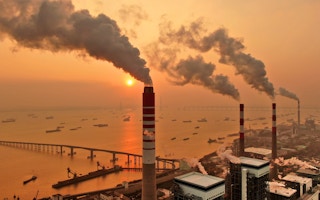The flurry of high-profile promises from governments and corporations to slash emissions over the past few years has yet to have any real impact on the amount of carbon dioxide in the atmosphere, with CO2 emissions reaching a historic high in 2021, driven mainly by China’s coal-powered economy.
To continue reading, subscribe to Eco‑Business.
There's something for everyone. We offer a range of subscription plans.
- Access our stories and receive our Insights Weekly newsletter with the free EB Member plan.
- Unlock unlimited access to our content and archive with EB Circle.
- Publish your content with EB Premium.
Global energy-related carbon dioxide emissions increased by 6 per cent last year, to a record 36.3 billion tonnes. The yearly increase in emissions — of more than two billion tonnes — is also the largest on record, offsetting the previous pandemic-induced dip in emissions in 2020, according to analysis from the International Energy Agency (IEA) on Tuesday.
The bulk of global emissions growth came from China, which produces and consumes more than half of the global supply of coal, according to the IEA. China was the only major global economy to grow in both 2020 and 2021. Its CO2 emissions rose above 11.9 billion tonnes, and now account for 33 per cent of the global total, the IEA said.
Burning coal — the most powerful man-made climate agitant — was the main reason for China’s rise in emissions, as the country responded to a record-breaking increase in electricity demand. Although China’s use of renewable energy grew at an historic speed in 2021, coal was used to meet more than half of the rise in electricity demand.
China plans a massive increase in coal mining in a bid to reduce its reliance on imports. The country’s National Development and Reform Commission, told country officials late last week that it wanted to boost domestic production capacity by about 300 millions tonnes, according to Bloomberg. Efforts to build domestic supply to fortify its energy security will likely undermine its ambitious climate goals.
China has said that coal consumption should begin to fall off in the second half of this decade as it strives to peak emissions across the economy by 2030.
Coal also fuelled the rebound of India’s emissions, which rose above 2019 levels in 2021. Coal-fired power generation reached a record high in the country, jumping 13 per cent above the pre-pandemic level as growth in renewables slowed.
Globally, coal contributed to 40 per cent of the growth in emissions in 2021, reaching 15.3 billion tonnes, an all-time high.
Spikes in natural gas prices and bottlenecks which choked supply led to higher coal consumption as economies, hobbled by the pandemic, tried to kickstart their economies. Carbon emissions from gas climbed above their 2019 levels, to 7.5 billion tonnes, while emissions from oil, at 10.7 billion tonnes, remained below pre-pandemic levels, mainly because of the ongoing slump in air travel.
Carbon emissions in the United States were 4 per cent lower than their 2019 levels in 2021 and in Europe they were 2.4 per cent lower. Japan’s emissions rebounded by less than 1 per cent in 2021.
Per capita carbon emissions in developed countries are now 8.2 tonnes per person on average, dropping below China’s 8.4 tonnes.
Wavering net-zero promises
Countries and companies representing about 90 per cent of global GDP have committed to achieve net-zero emissions to cap a global temperature increase of 1.5°C by the end of the century, but the rise in global emissions calls decarbonisation efforts into question.
China has committed to achieve net-zero emissions by 2060, and the country could reduce global warming by an average 0.2°C to 0.3°C if it hits that target, according to analysis by Climate Action Tracker (CAT). However, CAT says China’s climate targets are “highly insufficient” given its size and dependence on coal.
India’s dependence on the polluting fossil fuel also undermines the country’s 2070 net-zero target, set at the COP26 climate negotiations in November. The country’s prime minister Narendra Modi has called for better access for climate finance and technology to help it transition from dirty energy, noting that India is home to 17 per cent of the world’s population but produces only 5 per cent of global carbon emissions.
Shareholder advocacy non-profit As You Sow called on companies and policymakers to “go beyond targets” and implement immediate emissions reductions as the effects of climate change are increasingly being felt, from wild fires in Australia to flooding in Germany.
A study by the non-profit, published in February, found that most of the US’s biggest 50 companies lack comprehensive, 1.5 degree-aligned emissions reduction goals and do not publicly share their progress. Sustainability consultancy ENGIE Impact found that 60 per cent of firms in Asia Pacific do not have any decarbonisation targets at all.
Companies need to pursue ambitious near-term carbon-cutting targets, robust transition plans detailing steps to achieve targets, and leadership in pushing for sweeping climate policy, As You Sow president Danielle Fugere said.
“It is imperative for the safety of human society and the global economy that emissions are reduced immediately in line with the Paris Agreement. When it comes to climate change, we will not be given second chances, so the private sector must create climate transition plans that prioritise accountability and transparency,” Fugere said.








